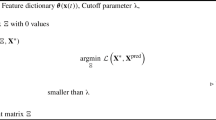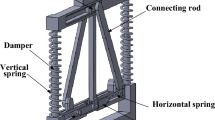Abstract
In this paper a novel model order reduction method for nonlinear models, based on decoupled multi-model, via trajectory piecewise-linearization is proposed. Through different strategies in trajectory piecewise-linear model reduction, model order reduction of a trajectory piecewise-linear model based on output weighting (TPWLOW), has been developed by authors of current work. The structure of mentioned work was founded based on Krylov subspace method, which is appropriate for high order models. Indeed the size of the Krylov subspaces may increase with the number of inputs of the system. As a result, the use of Krylov subspace method may become deficient the case for multi-input systems of order few decades. This paper aims to generalize the idea of model reduction of TPWLOW model by concentrating on balanced truncation technique which is appropriate for medium size systems. In addition, the proposed method either guarantees or provides guaranteed stability in some mentioned conditions. Finally, applicability of the reduced model, instead of high-order decoupled multi-model in weighting multi-model controllers, is investigated through the control of a nonlinear Alstom gasifier benchmark.
Similar content being viewed by others
References
A. C. Antoulas, Approximation of Large-scale Dynamical Systems, SIAM, Philadelphia, 2005.
E. Malekshahi and S. M. A. Mohammadi, “The model order reduction using LS, RLS and MV estimation methods,” International Journal of Control, Automation and Systems, vol. 12, no. 3, pages: 572–581, 2014. [click]
A. Benaicha, G. Mourot, K. Benothman, and J. Ragot, “Determination of principal component analysis models for sensor fault detection and isolation,” International Journal of Control, Automation and Systems, vol. 11, no. 2, pp. 296–305, 2013. [click]
M. Rewienski, A Trajectory Piecewise-Linear Approach to Model Order Reduction of Nonlinear Dynamical Systems, PhD thesis, Massachusetts Institute of Technology, USA, 2003.
M. Rewienski and J. White, “A trajectory piecewise-linear approach to model order reduction and fast simulation of nonlinear circuits and micromachined devices,” Proceedings of IEEE/ACM International Conference on Computer Aided-Design, San Jose, CA, USA, pp. 252–257, 2001.
M. Rewienski and J. White, “A trajectory piecewise-linear approach to model order reduction and fast simulation of nonlinear circuits and micromachined devices,” IEEE Transactions on Computer-aided Design, vol. 22 no. 2, pp. 155–170, 2003. [click]
D. Vasilyev, M. Rewienski, and J. White, “A TBR-based trajectory piecewise-linear algorithm for generating accurate low-order models for nonlinear analog circuits and mems,” Proceedings of the ACM/IEEE Design Automation Conference, pp. 490–495, 2003.
B. N. Bond and L. Daniel, “Stable reduced models for nonlinear descriptor systems through piecewise-linear approximation and projection,” IEEE Transactions on Computeraided Design of Integrated Circuits and Systems, vol. 28, no. 10, pp. 1467–1480, 2009. [click]
B. Lohmann and R. Eid, “Efficient order reduction of parametric and nonlinear models by superposition of locally reduced models,” Methoden und Anwendungen der Regelungstechnik, Erlangen Munchener Workshops, 2007 und 2008, pp.1–20, Shaker 2009.
S. A. Nahvi, M. Nabi, and S. Janardhanan, “Adaptive sampling of nonlinear system trajectory for model order reduction,” Proceedings of IEEE International Conference on Modeling, Identification and Control (ICMIC), pp. 1314–1320, 2012.
Z. Yu, J. Yu, and H. R. Karimi, “Model reduction of fuzzy logic systems,” Mathematical Problems in Engineering, vol. 2014, Paper ID 874530, 2014. [click]
Y. Wei, J. Qiu, H. R. Karimi, and M. Wang, “Model reduction for continuous-time Markovian jump systems with incomplete statistics of mode information,” International Journal of Systems Science, vol. 45, no. 7, pp. 1496–1507, 2015. [click]
Y. Wei, M. Wang, H. R. Karimi, N. Wang, and J. Qiu, “H ∞ model reduction for discrete-time Markovian jump systems with deficient model information,” Mathematical Problems in Engineering, vol. 2013, Paper ID 537174, 2013. [click]
R. Orjuela, B. Marx, J. Ragot, and D. Maquin, “State estimation for nonlinear systems using a decoupled multiple mode,” International Journal of Modeling Identification and Control, vol. 4, no. 1, pp. 59–67, 2008. [click]
J. M. Pak, C. K. Ahn, Y. S. Shmaliy, P. Shi, and M. T. Lim, “Switching extensible FIR filter bank for adaptive horizon state estimation with application,” IEEE Transactions on Control Systems Technology, vol. 24, no. 3, pp. 1052–1058, 2016. [click]
R. Orjuela, B. Marx, J. Ragot, and D. Maquin, “On the simultaneous state and unknown inputs estimation of complex systems via a multiple model strategy,” IET Control Theory & Applications, vol. 3, no. 7, pp. 877–890, 2009.
E. P. Gatzke and F. J. Doyle III, “Multiple model approach for CSTR control,” Proc. of 14th IFAC World Congress, Beijing, China, pp. 343–348, 1999.
F. Ferranti, G. Antonini, T. Dhaene, and L. Knockaert, “Passivity-preserving interpolation-based parameterized model order reduction of PEEC models based on scattered grids,” International Journal of Numerical Modeling: Electronic Networks, Devices and Fields, vol. 24, no. 5, pp. 478–495, 2011. [click]
S. S. Mohseni, M. J. Yazdanpanah, and A. Ranjbar N., “New strategies in model order reduction of trajectory piecewise-linear models,” International Journal of Numerical Modeling: Electronic Networks, Devices and Fields, John Wily & Sons, vol. 29, no. 4, pages 707–725, 2016. [click]
S. Gugercin and A. C. Antoulas, “A survey of model reduction by balanced truncation and some new results,” International Journal of Control, vol. 77, no. 8, 2004. [click]
R. Dixon and A. W. Pike, “Alstom benchmark challenge II on gasifier control,” IEE Proceedings-Control Theory and Applications, vol. 153, no. 3, pp. 254–261, 2006. [click]
B. N. Asmar, W. E. Jones, and J. A. Wilson, “A process engineering approach to the ALSTOM gasifier problem,” Proceedings of the Institution of Mechanical Engineers Part I Journal of Systems and Control Engineering, vol. 214, no. 6, pp. 441–452, 2000.
R. Agustriyanto and J. Zhang, “Control structure selection for the Alstom gasifier benchmark process using GRDG analysis,” International Journal of Modeling Identification and Control, vol. 6, no. 2, pp. 126–135, January 2009.
P. J. Gawthrop, “Continuous-time local state local model networks,” IEEE Conference on Systems, Man and Cybernetics, Vancouver, Canada, pp. 852–857, 1995.
G. Gregorcic and G. Lightbody, “Control of highly nonlinear processes using self-tuning control and multiple/local model approaches,” Proc. of IEEE International Conference on Intelligent Engineering Systems, Portoroz, Slovenia, pp. 167–171, 2000.
X. Xie, D. Yue, and H. Zhang, “Control synthesis of discrete-time T-S fuzzy systems via a multi-instant homogenous polynomial approach,” IEEE Transactions on Cybernetics, vol. 46, no. 3, pp. 630–640, 2016. [click]
X. Zhao, L. Zhang, P. Shi, and M. Liu, “Stability and stabilization of switched linear systems with mode-dependent average dwell time,” IEEE Transactions on Automatic Control, vol. 57, no. 7, pp. 1809–1815, 2012. [click]
B. Niu, H. R. Karimi, H. Wang, and Y. Liu, “Adaptive output-feedback controller design for switched nonlinear stochastic systems with a modified average dwell-time method,” IEEE Transactions on Systems, Man, and Cybernetics: Systems, vol. 47, no. 7, pp. 1371–1382, 2017.
B. Niu and J. Zhao, “Barrier Lyapunov functions for tracking control of constrained nonlinear switched systems,” Systems and Control Letters, vol. 62, no. 10, pp. 963–971, 2013. [click]
X. Xie, D. Yang, and H. Ma, “Observer design of discretetime T-S fuzzy systems via multi-instant homogenous matrix polynomials,” IEEE Transactions on Fuzzy Systems, vol. 22, no. 6, pp. 1174–1179, 2014.
C. K. Ahn, P. Shi, and M. V. Basin, “Deadbeat dissipative FIR filtering,” IEEE Transactions on Circuits and Systems I, vol. 63, no. 8, pp. 1210–1221, 2016. [click]
C. K. Ahn, P. Shi, and M. V. Basin, “Two-dimensional dissipative control and filtering for Roesser model,” IEEE Transactions on Automatic Control, vol. 60, no. 7, pp. 1745–1759, 2015. [click]
Author information
Authors and Affiliations
Corresponding author
Additional information
Recommended by Associate Editor Choon Ki Ahn under the direction of Editor Hamid Reza Karimi.
Seyed Saleh Mohseni received his B.Sc. degree in Bio-Electric Engineering from Sahand University of Technology, Tabriz, Iran, in 2006, an M.Sc. degree in Control Engineering from Malek Ashtar University of Technology, Tehran, Iran, in 2008, and a Ph.D. degree in Control Engineering from Science and Research Branch, Islamic Azad University, Tehran, Iran, in 2016. He is working as assistant professor at Islamic Azad University, Nour Branch, Nour, Iran. His research interests include nonlinear control, process control, and model reduction.
Mohammad Javad Yazdanpanah received his B.Sc., M.Sc., and Ph.D. degrees all in Electrical Engineering from Isfahan University of Technology, Isfahan, Iran in 1986, University of Tehran, Tehran, Iran, in 1988, and Concordia University, Montreal, Quebec, Canada in 1997, respectively. His Ph.D. thesis entitled “Control of flexible-link manipulators using nonlinear H∞ techniques” was ranked outstanding. From 1986 to 1992, he worked with the Engineering Research Center, Tehran, Iran, as an R&D engineer and culminating as the chairman of the System Design Division. In 1998, he joined the School of Electril and Computer Engineering, University of Tehran, Tehran, Iran, where he is now a Professor and director of the Advanced Control Systems Laboratory (ACSL). Dr. Yazdanpanah’s research interests are in the areas of analysis and design of nonlinear/optimal/adaptive control systems, robotics, control on networks, and theoreticcaal and practical aspects of neural networks.
Abolfazl Ranjbar Noei was born in Gorgan, Iran, in 1964. He received his B.Sc. in 1988 from Isfahan Univ. of Technology, Isfahan, IRAN, and an M.Sc. in 1992 from Tarbiat Modares Univ., Tehran, IRAN and a Ph.D. in 2000 from Surrey Univ. UK, all in the Control Engineering. Currently he is a professor at the Control Eng. Dept. of Babol Noshirvani Univ. of Tech., Babol, IRAN. His research Interests are machine control, nonlinear and chaos systems, robust and adaptive control and fractional calculus.
Rights and permissions
About this article
Cite this article
Mohseni, S.S., Yazdanpanah, M.J. & Noei, A.R. Model order reduction of nonlinear models based on decoupled multi-model via trajectory piecewise linearization. Int. J. Control Autom. Syst. 15, 2088–2098 (2017). https://doi.org/10.1007/s12555-016-0536-2
Received:
Revised:
Accepted:
Published:
Issue Date:
DOI: https://doi.org/10.1007/s12555-016-0536-2




